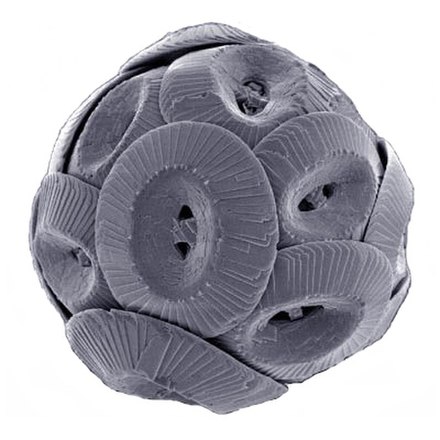Stereom
| Part of a series related to |
| Biomineralization |
|---|
 |
Stereom is a calcium carbonate material that makes up the internal skeletons found in all echinoderms, both living and fossilized forms. It is a sponge-like porous structure which, in a sea urchin may be 50% by volume living cells, and the rest being a matrix of calcite crystals. The size of openings in stereom varies in different species and in different places within the same organism.[1] When an echinoderm becomes a fossil, microscopic examination is used to reveal the structure and such examination is often an important tool to classify the fossil as an echinoderm or related creature.[2]
Evolution
Stereom was the first form of biomineralization to evolve in deuterostomes, predating the evolution of spicules in tunicates and bone in vertebrates.[3] Stereom likely evolved before other distinctive traits of echinoderms, such as radial symmetry, as it is present in basal echinoderms with bilaterally symmetric or asymmetric body plans.[4] Stereom may have evolved alongside a transition in ocean chemistry from an aragonite sea to a calcite sea, which occurred late in Cambrian Stage 2.[5][3]
In the largely falsified[6] calcichordate hypothesis, stereom was believed to have been present in the common ancestor of echinoderms and vertebrates. However, the genes which code for stereom are unique to echinoderms, indicating that it is likely that stereom is a synapomorphy of echinoderms, and that all stereom-bearing fossil taxa belong to the echinoderm total group.[7][8]
References
- ^ Edmund Bäeuerlein, Handbook of Biomineralization: . Biomimetic and bioinspired chemistry, Wiley-VCH, 2007 ISBN 3-527-31805-4, page 393
- ^ Paul D. Taylor, David N. Lewis Fossil Invertebrates Harvard University Press, 2007 ISBN 0-674-02574-1 pages 163-164
- ^ a b Kouchinsky, Artem; Bengtson, Stefan; Runnegar, Bruce; Skovsted, Christian; Steiner, Michael; Vendrasco, Michael (2011). "Chronology of early Cambrian biomineralization". Geological Magazine. 149 (2): 221–251. doi:10.1017/S0016756811000720.
- ^ Zamora, Samuel; Rahman, Imran A.; Smith, Andrew B. (2012-06-06). "Plated Cambrian bilaterians reveal the earliest stages of echinoderm evolution". PLOS ONE. 7 (6). Keith A. Crandall (ed.): –38296. Bibcode:2012PLoSO...738296Z. doi:10.1371/journal.pone.0038296. ISSN 1932-6203. PMC 3368939. PMID 22701623.
- ^ Zamora, Samuel; Rahman, Imran A. (2015). "Deciphering the early evolution of echinoderms with Cambrian fossils". Palaeontology. 57 (6): 1105–1119. doi:10.1111/pala.12138. hdl:1983/951cc086-7ed1-469b-98ac-2cc338c4e823. ISSN 0031-0239.
- ^ Lefebvre, Bertrand; Guensburg, Thomas E.; Martin, Emmanuel L.O.; Mooi, Rich; Nardin, Elise; Nohejlová, Martina; Saleh, Farid; Kouraïss, Khaoula; El Hariri, Khadija; David, Bruno (2019). "Exceptionally preserved soft parts in fossils from the Lower Ordovician of Morocco clarify stylophoran affinities within basal deuterostomes". Geobios. 52: 27–36. Bibcode:2019Geobi..52...27L. doi:10.1016/j.geobios.2018.11.001. ISSN 0016-6995.
- ^ Bottjer, D. J.; Davidson, E. H.; Peterson, K. J.; Cameron, R. A. (2006-11-10). "Paleogenomics of Echinoderms". Science. 314 (5801): 956–960. Bibcode:2006Sci...314..956B. doi:10.1126/science.1132310. PMID 17095693. S2CID 12789370.
- ^ Rahman, Imran A. (2009). "Making sense of carpoids". Geology Today. 25 (1): 34–38. Bibcode:2009GeolT..25...34R. doi:10.1111/j.1365-2451.2009.00703.x. S2CID 129493134.